高中英语人教版必修2unit3ComputersUsinglanguage教案(系列二)
- 格式:doc
- 大小:46.50 KB
- 文档页数:3
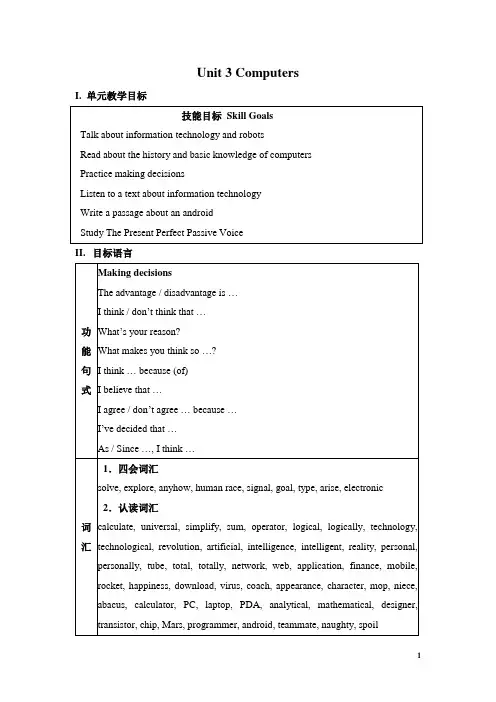
Unit 3 Computers I. 单元教学目标II. 目标语言III. 教材分析与教材重组1. 教材分析本单元以computers为话题,旨在通过单元教学,综合听、说、读、写等多种形式,使学生了解计算机和信息技术的产生和发展过程及其在我们的学习、工作、娱乐等生活中所起的重要作用,激发学生对信息技术的兴趣。
1.1 Warming up提供几幅与计算机有关的图片,形象地说明了计算机的发展历程,并用三个问题引发学生对这一话题的思考,从而起到热身的作用。
1.2 Pre-reading根据文章内容预设问题,检查学生对computers相关知识及应用的了解。
学生对computers的了解可能参差不齐,这更能激发学生想获取更多知识的欲望,从而引出下面的阅读文章——WHO AM I?。
1.3 Reading中以别致的标题WHO AM I?引起学生的好奇心,使学生迫不急待地阅读这篇文章,并判断出“I”是computer,从而对文章的内容印象更深刻。
文章以第一人称的形式按时间先后顺序讲述了computers的产生、发展和现状,并用拟人化的口吻表达了computers乐于为人类服务的精神。
1.4 Comprehending 1 通过scanning的方式完成反映计算机发展历程的时间进程;2 通过填表的形式帮助学生宏观梳理文章结构,找出每个段落的主题句(论点)及具体的支持性论据;3 是读后讨论,要求学生结合自己的生活实际讨论计算机如何改变了我们的生活。
1.5 Learning about language分词汇(Discovering useful words and expressions)和语法(Discovering useful structures)两大部分。
Discovering useful words and expressions 1 根据单词释义写出相对应的词汇,考查学生对WHO AM I? 文章中的重要词汇及短语的理解。
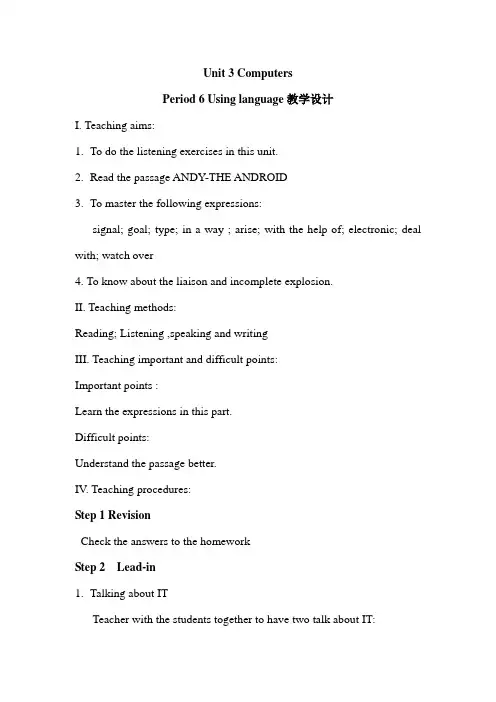
Unit 3 ComputersPeriod 6 Using language教学设计I. Teaching aims:1.To do the listening exercises in this unit.2.Read the passage ANDY-THE ANDROID3.To master the following expressions:signal; goal; type; in a way ; arise; with the help of; electronic; deal with; watch over4. To know about the liaison and incomplete explosion.II. Teaching methods:Reading; Listening ,speaking and writingIII. Teaching important and difficult points:Important points :Learn the expressions in this part.Difficult points:Understand the passage better.IV. Teaching procedures:Step 1 RevisionCheck the answers to the homeworkStep 2 Lead-in1.Talking about ITTeacher with the students together to have two talk about IT:What is I T?(Information Technology)Can you tell some ITs?( students share their answers)Step 3 Listening1)Listen to the whole text and try to write down the main idea in onesentence.Two students are talking about information technology.2). Listen for the second time and fill in the chart on exercise 3 with your partner( Teacher had better play the listening materials one more times to make sure all the students can listen clearly)3). Discussion:What are the advantages and disadvantages of each form of IT?In small groups discuss this question and put your ideas on to the chart. Then decide when each kind of IT is most useful.Use the reasoning expressions in your discussion.Step 4. Reading1.Fast-readingWho is Andy?What does he work as in the team?2. Careful readingPara 1:Name: AndyAppearance(外貌):_____________________Size: __________________Ability: ___________________________Job: _______________________Character(个性): _____Para 2:1). What is Andy’s opinion about the match in Seattle?2) . What did Andy think they should do?3).What did their programmer do to help them?First she _________ them ______ all thepossible moves ;Then she prepares _______ moves to use ifa new situation ______________.4). What is Andy’s wish?3. True or False1). The androids can be often used to play games together.2). I am a striker, so I must run very fast.3). In the game, I sometimes speak to my teammates in English.4). Our team won the match last year in Seattle.5). I thought the result of the match Nagoya was unexpected.6). I can make any move in the game just like a human.Step 5. Deal with the language points in this part.1.What are the advantages and disadvantages of each form of IT?1) advantage n. 优点; 优势; 有利条件都市生活有几个优点。

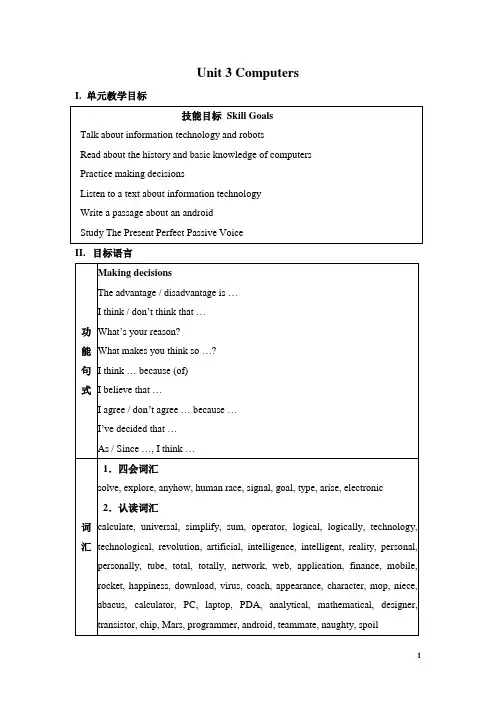
Unit 3 Computers I. 单元教学目标II. 目标语言III. 教材分析与教材重组1. 教材分析本单元以computers为话题,旨在通过单元教学,综合听、说、读、写等多种形式,使学生了解计算机和信息技术的产生和发展过程及其在我们的学习、工作、娱乐等生活中所起的重要作用,激发学生对信息技术的兴趣。
1.1 Warming up提供几幅与计算机有关的图片,形象地说明了计算机的发展历程,并用三个问题引发学生对这一话题的思考,从而起到热身的作用。
1.2 Pre-reading根据文章内容预设问题,检查学生对computers相关知识及应用的了解。
学生对computers的了解可能参差不齐,这更能激发学生想获取更多知识的欲望,从而引出下面的阅读文章——WHO AM I?。
1.3 Reading中以别致的标题WHO AM I?引起学生的好奇心,使学生迫不急待地阅读这篇文章,并判断出“I”是computer,从而对文章的内容印象更深刻。
文章以第一人称的形式按时间先后顺序讲述了computers的产生、发展和现状,并用拟人化的口吻表达了computers乐于为人类服务的精神。
1.4 Comprehending 1 通过scanning的方式完成反映计算机发展历程的时间进程;2 通过填表的形式帮助学生宏观梳理文章结构,找出每个段落的主题句(论点)及具体的支持性论据;3 是读后讨论,要求学生结合自己的生活实际讨论计算机如何改变了我们的生活。
1.5 Learning about language分词汇(Discovering useful words and expressions)和语法(Discovering useful structures)两大部分。
Discovering useful words and expressions 1 根据单词释义写出相对应的词汇,考查学生对WHO AM I? 文章中的重要词汇及短语的理解。
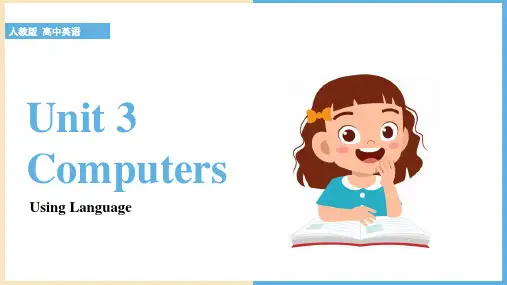
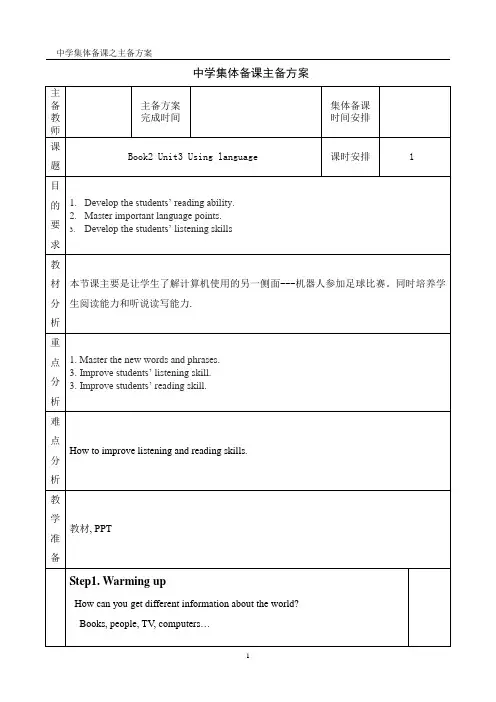
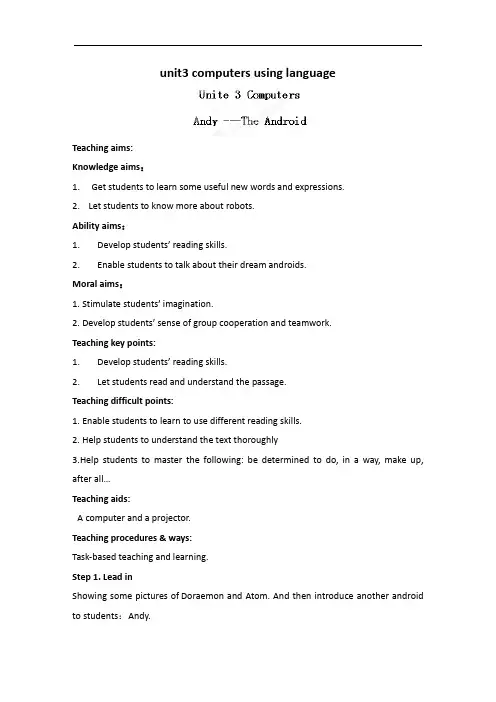
unit3 computers using languageTeaching aims:Knowledge aims:1.Get students to learn some useful new words and expressions.2.Let students to know more about robots.Ability aims:1.Develop students’ reading skills.2.Enable students to talk about their dream androids.Moral aims:1. Stimulate students’ imagination.2. Develop students’ sense of group cooperation and teamwork.Teaching key points:1.Develop students’ reading skills.2.Let students read and understand the passage.Teaching difficult points:1. Enable students to learn to use different reading skills.2. Help students to understand the text thoroughly3.Help students to master the following: be determined to do, in a way, make up, after all…Teaching aids:A computer and a projector.Teaching procedures & ways:Task-based teaching and learning.Step 1. Lead inShowing some pictures of Doraemon and Atom. And then introduce another android to students:Andy.Step 2. Reading.1.Skimming1) From the text ,we know the passage is about______A. a football match between humansB. a football match between androidsC. a football match between human and androidsD. a basketball match between androids2) Who’s Andy?A. a dogB. a boyC. an androidD. a bird3) What is he good at?A. runningB. walkingC. playing footballD. calculating2. Detailed reading.Task 1 Listen to the tape and finish the exercises.1) What part does Andy play in the team?A. goal keeperB. backC. strikerD. center2) Andy thinks the match in Seattle is________A. wonderfulB. importantC. unfairD. fair3) Why can Andy play football like human?A. Because he has a computer in it.B. Because he is a human.C. Because his coach told him.D. because he is a real man.Task 2 Read the statements first and then read the passage by yourself. Decide whether they are true or false.1) The androids can often play games together. F2) Andy is much bigger than a human. F3) The android can think like a human by themselves. F4) In the game, I need to speak to my teammates in English. F5) Andy failed to win the competition because his team was less intelligent than his rival(对手). TTask 3 Post-reading.Sum up the main idea.The story is about the ________ called _______,who is good at_________________. And his___________ makes him think and move like a______. However, they _____ in the ___________hosted in the USA, because the other teamhad a new kind of_________. After that, he will ask his programmer to improve his __________ .Step 5 SpeakingTell students that Pair-work to discuss how to design your own androids. The following questions and expressions can help you:What would you like it to look like?Do you want it to be like a man or woman, or neither?What are some of the things you would like it to do?How much will it cost?In my opinion…I ( don’t ) think that…What is your reason ?I would like it to do some sports with me.I would like it to dance for me.It costs…Then ask 2-3 pairs to report to the whole class.The the sample dialogue to them if it’s nece ssary.A: What kind of robot have you decided to make?B: I've decided that we should have a homework android. It could do all our work after class and leave us more time to play football.A: OK. But what do you think it should look like?B: In my opinion, it should have four arms to carry the books, a large head to remember all the lessons and a printer to write out the answers. What do you think? A: Well, that sounds sensible. Perhaps it could also put all the exercises into specially marked boxes for each subject so we could find them quickly. What about putting that in its stomach area?B: Do you want it to be a man or a woman? You can choose.A: I've decided it should be a girl.B: What's your reason?A: Girls are so hard-working.B: Sounds good to me! Let's draw it now!Step 6. Homework.Draw a dream android.Make sentences with the language points we’ve learned today.教学反思整个教学过程非常流畅,学生参与度很高。

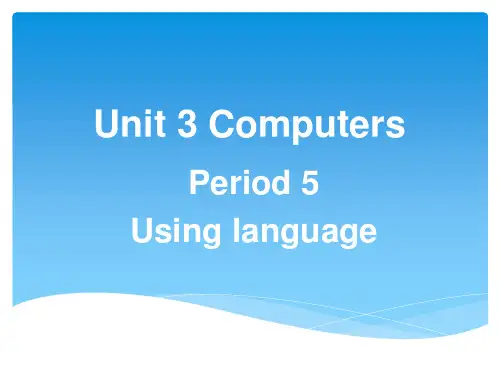
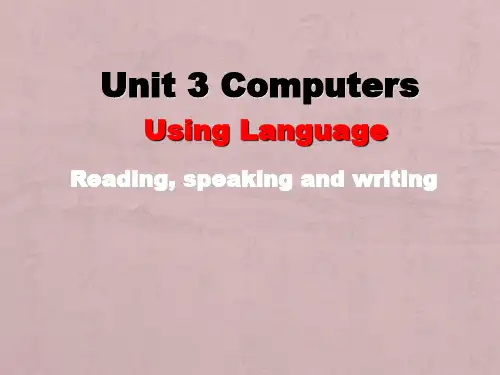
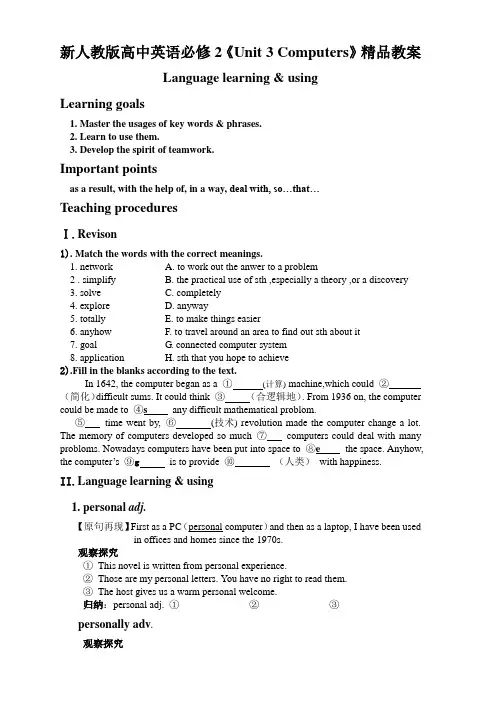
新人教版高中英语必修2《Unit 3 Computers》精品教案Language learning & usingLearning goals1. Master the usages of key words & phrases.2. Learn to use them.3. Develop the spirit of teamwork.Important pointsas a result, with the help of, in a way, deal with, so…that…Teaching proceduresⅠ.Revison1). Match the words with the correct meanings.1. network A. to work out the anwer to a problem2 . simplify B. the practical use of sth ,especially a theory ,or a discovery3. solve C. completely4. explore D. anyway5. totally E. to make things easier6. anyhow F. to travel around an area to find out sth about it7. goal G. connected computer system8. application H. sth that you hope to achieve2).Fill in the blanks according to the text.In 1642, the computer began as a ①(计算) machine,which could ②(简化)difficult sums. It could think ③(合逻辑地). From 1936 on, the computer could be made to ④s any difficult mathematical problom.⑤time went by, ⑥(技术) revolution made the computer change a lot. The memory of computers developed so much ⑦computers could deal with many probloms. Nowadays computers have been put into space to ⑧e the space. Anyhow, the computer’s ⑨g is to provide ⑩(人类)with happiness.nguage learning & using1. personal adj.【原句再现】First as a PC(personal computer)and then as a laptop, I have been used in offices and homes since the 1970s.观察探究①This novel is written from personal experience.②Those are my personal letters.You have no right to read them.③The host gives us a warm personal welcome.归纳:personal adj.①____________ ②____________ ③____________personally adv.观察探究①Personally, I am against his plan.②The host welcomed his guests personally.归纳:personally ①____________ ②____________2. as a result【原句再现】As a result I totally changed my shape.观察探究①It doesn't often rain in summer. As a result,we have to water the garden.②As a result of the accident, he became lame(跛).as a result意思是_______,只能单独用;as a result of= ___ _ __, 意思是_______ 即学活用A. 用as a result或as a result of 填空。
人教版高中英语必修2教案Unit 3 ComputersThe topic of this unit are information technology,history and basic knowledge of computers and robots。
The main theme is computers which is connected with teaching students a little more of the history and development of computers and applications computers will be vital to the modernization of China.It is important for students to understand that the development of computers has been a very recent thing which has only been 100 years since Charles Babbage began to make his first machine that was the predecessor of the personal computers we use today. Understanding the history of computers will help the students to see that there will be many changes ahead in the development of computers and arouse students` interest in learning computers.New words and collocations: calculate, universal, simplify, sum, operator, logical, technology, technological, revolution, artificial, intelligence, intelligent, solve, reality, personal, tube, total, net work, web, application, finance, mobile, rocket, explore, anyhow, goal, happiness, download, virus, signal, type, coach, arise, electronic, appearance, character, mop, niece, from….on…, as a result, so …that…, human race, in a way, with the help of, deal with, watch overAbility aims: arouse the students` great interest in learning computers and let them learn to use them in their daily life.Difficult points: how to develop students` reading skills, express their opinions and use personification and chronology when writing.Important points: let them learn more about the history and basic knowledge of computers and different reading skills.Step 1 Leading in the topic1. Show them some pictures of an abacus, a calculator, a huge computer, a laptop anda PC. In some groups, discuss what they have in common, and then rank them according to the time of their appearance.2. Ask students to give their opinions and remind them of using the following expressions:I think that ……In my opinion, ……I believe that……What`s your reason?Why do you think so ?3. Ask some students to talk about what they know about computers.Step 2. Predicting by talking free1. Ask students to look at the heading and picture to guess what the passage might be about.2. Ask some students to give their opinions by answering the question: How have computers changed our life? Do you know in what ways computers are used today?Step 3. Reading1. Look at the picture and title to predict what the passage might be about?3. Read the text carefully for the information to complete the table below, describing4.根据课文内容填空5. Read the text again to underline the expressions and write down into their notebook after class as homework: begin as, a calculating machine, be built as, as that time, a technological revolution, artificial, intelligence, write a book, make…work as, solve problems, from then on, in size, both…and…, by the 1940s, go by, as a result, change one`s shape, so ….that…, be lonely, stand there by oneself, be connected by, share one`s knowledge with…, become important in…, put…into…., as well as, provide….with…, be filled with…, a devoted friend, the human race5. Listen to the text and skim the text once more and identify the difficult sentences. Let them try analyzing the structures of them.Step 4 Interview gamesAsk students to work in pairs. Suppose one is a journalist and the other is a computer, the journalist is interviewing the computer.Step 5 Learning personification and chronologyPersonification means to treat something as if it were human or had human qualities. It is of the most effective ways of using words figuratively.Chronology means to describe things in order of time which is often used in recounting an event or describing the life of someone. It is an effective way to make a mass of things clear.An version:I, the computer, was a calculating machine in 1642 in France. Then I was built as an Analytical Machine, which was a technological revolution. I became a “universal machine” in 1936 to solve any mathematical problem. I was not very big at first then I became huge, the size of a large room before I was made smaller and smaller.I became clever and quicker and was connected with other computers and turned out to be part of a network in the early 1960s. I was brought into people`s, and many new applications have been found for me.Step 5 Closing down by spoken practiceTalk about the development of computers by answering the questions:1). Do you have your own computer at home?2). How familiar with computers do you think you are?3). How many times do you access the Internet newspaper in a week?4). How many times do you access the World Wide Web in a week?5). How many times do you send the e-mails in a week?6). How many hours do you spend in internet “chat” group in a week?7). Do you think the commercial services on the net are reliable?8). In general, how positive or negative an experience is it for you to work with computers?9). In general, what effects do you think the computer technology has had on your study?10). In general, what effects do you think the computer technology has on human societies and cultures?Step 6 Homework1. Go over the text, and try to learn all the useful words and expressions by heart2. Finish the exercises in comprehending on page 19.Artificial intelligence means man-made intelligence while “real intelligence”is the intelligence that human that human beings are born with. The term “artificial” includes all the calculations that a computer can do. It is different from human intelligence because itonly works with electricity and can be turned off when the machine is unplugged fro the wall.Transistors are a way of sending and storing information that only take up a small space. They meant that computer could be made smaller and they led to computers becoming small and personal.A network is a number of computers that are joined together so that they all show the same program. So a number of students can work in the same room on the same program but at different computers.The Internet (WWW) is a worldwide information resource where people can do research, go shopping or sending messages to friends. When they send messages they do it by “e-mail” or “electronic mail”. The messages are sent by satellite to special place on the ground that can receive them. Them they are sent to the address where the person can open them and read them like a letter.The 1970s was when computers became small enough to come into people`s homes. These computers are called “personal computers”.The second period: Learning about important language pointsKnowledge aims:1. Get students to learn and grasp the important useful new words and expressions: calculating, calculator, PC, laptop, common, simplify, simple-minded, artificial intelligence, anyhow, totally, network, truly, race, birth, go by, deal with, human race2. Important useful sentence patterns:1) I began as a calculating machine in France in 1642.2) As time went by, I was made smaller and smaller.3)And my memory became so large that even I couldn`t believe it.3. Ability aims:Get students to use some useful new words and expressions correctly.4. Emotion aims:Stimulate students` interest in learning English and the spirit of cooperation.5. Important points:Enable them to grasp the usages of such important new words and expressions as common, any how, in common, in one`s opinion, deal with, etc.Get them to master the pattern “And my memory became so large that even I couldn`t believe it.”6. Difficult points:How to get the students to master the usages of the important expressionsGet students to understand some difficult and long sentences.Step 1 RevisionCheck the homework exercises.Ask some students to retell the development of computers.Step 2 V ocabulary study2. Review the new words and expressions in all the parts and have a dictation.Step 3 Practice for useful words and expressions1. Let students do exercise 1 in Learning about Language on page 20 and then check the answers.2. Question students on the meanings of those new words which will be used in Exercise 2 in Learning about Language on page 20.3. Explanation of some important words and expressions.1). common:usual or familiar; happening or found often in many places; shared by, belong to, done by or affecting most of the same group.Snow is common in cold countries.We shared a common purpose.He and I have a common interest; we both collect stamps.The common man in every country is anxious for the world peace.His ordinary supper consists of only bread and milk.This book is intended for the general reader, nor for the specialist.in common withhave nothing / something / little / a lot in common2). calculate: work out by using numbers or one`s judgment; estimateCalculate the cost of a journeyScientists have calculated that the world`s population will double by the end of the century.I calculate that we will reach Beijing at about 3 pm.Be calculated for / toIt is calculated that ….Calculate on / upon3) simplifyThis dictionary tries to simplify the meanings of words.4). so…that…He is such a kind man that everyone likes him.He started so early in the morning that he caught the first train.Those were such expensive books that we couldn`t afford to buy them.I made so many mistakes that I failed the exam.There is so little time that we couldn`t finish the task on time.5). in a wayYou`re quite right in a way.on the waybe in the waymake one`s wayfeel one`s way6). arise: become evident; appear; originateA new difficult has arisen.Use this money when the need arises.Arise from / out of sth. : follow as a result of sth.4. Sentence focus1). I began as a calculating machine in France in 1642.A walking stick, a swimming poo, a washing machine, a sleeping boy, exciting news 动名词作定语表示所修饰的名词的用途2). In 1936 my real father, Alan Turing, wrote a book about how I could be made to work as a “universal machine” to solve any difficult mathematical problem.how I could be made to work as a “universal machine”to solve any difficult mathematical problem.是宾语从句3). however, this reality also worried my designers.However.adv.可是, 然而; conj. 不论, 不管;We haven`t yet won, however, we shall try again.He hasn`t arrived,. He may, however, come later.He can answer the question however(=no matter how) hard it is.However sly(狡猾) a fox may be, it is no match for a good hunter.You will be lucky if he lets you go without a ticket. However, this does not always happen.Sally was amused, but I was very embarrassed.4). As time went by, I was made smaller.as time went by是时间状语从句,主句的谓语形式是一般过去时的被动语态.5). Over time my memory has developed so much that, like an elephant, I never forget anything I have been told. 比喻句子An elephant never forget. 大象永远不会遗忘.6). And my memory became so large that even I couldn`t believe it.用so….that….引导结果状语从句So bright was the moon that the flowers were bright by day. so连同它所修饰的形容词或者副词放在句首,表示强调.Step 4 Using words, expressions and patterns1. Do exercises 1 and 2 on page 56 in Using words and expressions2. Translate the sentences into English, using the words and expressions given in brackets.1). 在老师的帮助下, 你会发现处理和分享信息是不难的. (with the help of)2). 你很容易通过因特网与世界各地的人们进行交流. (communicate)3). 为每位教师购置一台电脑要花费很多钱,但这很值得. (After all)4). 她电脑用得好,现在很少用纸和笔写字了. (so…..that….)5). 如果出现新的情况, 他们会补充新的程序. (make up)Step 5 HomeworkFinish off the Workbook exercisesLearn the new words and expressions by heartThe third period: Learning about grammarStep 1 Revision1. Check the homework exercises.2. Dictate some new words and expressions.3. Translate the sentences into English1). 这消息太好了,简直不能相信.2). 他走得太匆忙了,以至于忘了带伞.Step 2 Grammar revision1. Revise the passive voice:the present passive voice: be + p.p;the present future passive voice: shall / will be + p. p2. Fill in the blanks with the right form of the verb given.1). Sailing races are held (hold) on the lake at 11 Tuesday.2). Food is served (serve) between 12:00 and 14:00 every day.3). Nobody will be allowed (allow) to enter the stadium without a ticket.4). Whoever breaks the law, he will be punished (punish).Step 3 Grammar learning1. Reading aloud and discovering by asking students to go back to page 18 to read the passage Who am I ? to pick out the present perfect passive voice and translate them into Chinese.Over time I have been changed quite a lot.I have been used in offices and home since the 1970s.I never forget anything I have been told.Since the 1970s many new applications have been found for me.I have also been put into space rockets…I have even been robots and used to make mobilphones.2. Look and think to sum up the structure of the present perfect passive voice: Have / has + been + p.pStep 4 Grammar practicehave / has done--------have / has been done现在完成时以及被动语态1.Change the following into the present perfect passive voice.We have made a plan.He has fixed the computer.We have bought a new personal computer.We have found many problems with our new computer.They have built a PC the way we wanted.We have used the computer every day since we bought it.We have written a lot of emails on the computer in the past years.2.Check errors in these sentences.3000 employees were laying off / laid off.A story will / be made up.An idea was putted / put forward for discussion.Has the book been give / given back to you yet?My bank loan will be payed / paid off in five years time.Nothing can be hold / held against me.She has never / been heard of.She was being /x knocked down by a bus.She was letted / let off with a fine.The candle was blow /blown out by the draught.The criminal were / was locked up.The flood water was be / x kept back by barriers.The inconvenience will / be made up for by this money.The keys must have been being / x left behind.The old cinema is being pull / pulled down.The protesters / are being held back by the police.Your jacket can be hanged / hang up over there.Step 5 consolidationAsk the students to do the exercises in Using structures on page 57.Step 6 HomeworkFinish off the workbook exercises.Preview the passage Andy-The Android on page 23. find the sentences in which the present perfect voice has been used, and see if you can put it into the active voice.Computer jargon (计算机行话)Bit : the smallest data unit, can either be a “0” or a “1”Byte: unit of data. See also Kilobyte, Megabyte, Gigabyte and Nibble.CPU: Central Processing Unit, another name for processorData: information stored on a computerDisk: A place to store dataLoad: Get data from a diskSave: Put data on a diskUSB: Universal Serial BusWWW: World Wide Web, part of the InternetThe Fourth period: Using Language: Listening and TalkingKnowledge aims:(1). Get the students to learn some useful new words and expressions;(2). Let the students learn the expressions of giving opinions, reasoning and making a decision: I think that….., in my opinion, ……., I think this is because ……., I don`t likethis ……, the advantage is….., let`s make our decision to do ……, I have decided …..Ability aims: enable them to catch and understand the listening materials to develop their listening ability.Important points: develop the students` listening and speaking ability to master different listening skills. Let them learn how to give opinions, reasons and make a decision.Difficult points: how to get them to listen and understand the materials correctly and how to develop their speaking ability.Step 1 RevisionCheck the homework exercises.Ask some students to translate some sentences using the present perfect passive voice.Step 2 Warming up by talking about ITWhat is information technology/ Information technology (IT) or information and communication technology (ICT) is the technology required for information processing. In particular the use of electronic computers and computer software to convert, store, protect, process, transmit and retrieve information from anywhere, anytime.Step 3 Listening and speaking on page 22Listen to the conversation about different kinds of information technology. Discuss the topic and add some advantages and disadvantages, write down the advantages and disadvantages in the chart on page 22.Step 4 Listening on page 551. Ask students to look at the 4 pictures and listen to the tape to find the three mentioned in the listening text and number them.2. Let them look at the boxes and then listen to the tape part by part to fill in the boxes.Step 5 Talking on page 551. Ask the students to read the directions and the expressions of giving opinions, reasoning and making a decision given below.2. Let the students list the advantages and disadvantages of each robot.3. Ask them have a discussion and make a decision which one is the best and give some reasons.Step 6 listening task on page 581. Ask students to discuss the following questions:What can the androids do for our everyday life?What else can they do for human beings?What can the androids do all these useful things for human beings?What are the similarities between robots and human beings?What are the differences between robots and human beings?Can androids become human beings in the future?2. Ask students to read the directions and listen to the tape to fill in the blank.3. Let students have a discussion on the rights that androids should have so that they will be treated better.Step 7 HomeworkFinish off the Workbook exercisesPreview the passage Andy—the android.The fifth period: Using language: Reading and SpeakingThis unit , the teaching emphasis will be put on developing students` reading abilities by reading extensively and speaking abilities by using the expressions of giving opinions, reasoning and making a decision to discuss in groups the advantages and disadvantages of having sporting robots take the place of human players.Ability aims: train students` speaking ability and enable them to learn how to give opinions, reasoning and make a decision.Important points:(1). Develop the students` reading skills by extensive reading.(2).Train students` speaking abilities by using the expressions giving opinions, reasoning and making a decision.Difficult points: how to get them learn to use reading strategies such as skimming and scanning. How to give opinions, reasons and make a decision.Step 1. Revision1. Check the homework exercises.2. Ask the students to go over Using words and expressions on page 56 to know more about the computers.Step 2. Warming up by a group discussion1. Ask students to talk about Andy—the android.2. Divide the students into several groups to discuss the advantages and disadvantages of having sporting robots to take the place of human players.Step 3 Reading the Sporting Robot on page 58-591. Look at the title and pictures and then guess what the passage is about.2. Skim for the answer to the following questions.What is Hua Fei?What is Hua Fei good at?What can it do?Did Hua Fei win any medal in the 79th Olympics?What problem does Hua Fei have now?3. Scan the text to get the detailed information and then do the exercise 1 on page 59.4. Practice reading aloud the second paragraph while listening to the tape.Step 4 Speaking task on page 59-60Have a discussion to work out the questions to be used to interview Hua Fei. After several minutes, ask some students to play it out.Step 5 Summing upAsk the students to think over the following questions and then sum up the expressions and the passage.1). What expressions do you use when giving opinions, reasons and making a decision.2). How do you feel after reading the passage The Sporting Robot? Do you think what will happen?Step 6 HomeworkFinish off the Workbook exercises.Find out information about robots and share with your classmates.The sixth period: Using language: Speaking, Reading and WritingThe emphasis of this unit is laid on developing students` writing ability which is the best way to test if students have mastered what they have learned.Ability aims: Get the students to learn to think creatively.Important points: Develop students` writing ability by using the expressions to give opinions, reasons and make a decision.Difficult points: How to get them to think creatively to understand others` feelings.Step 1. Revision1. Check the homework.Step 2 Warming upImagine computers can be put into different kinds of android. Show students some pictures of different kinds of android.Talk about football androids or other sporting androids.Step 3 ReadingRead the passage Andy—the android and underline all the useful expressions and new words.Read it again to get the main idea.Step 4 Discussing how to design an androidDiscuss how to design their own android, the following questions may help:What would you like it to be?What would you like it to do?Step 5 Selling computersFirst, have a discussion in pairs intending to sell computer to someone. Then get them write a report to persuade the other to buy the robot by giving 3 or more reasons.Step 6 WritingSuppose you are a famous reporter. You have interviewed Hua Fei, a sporting robot. Now you write a news article for the school newspaper.1. Show them English newspapers and let them discuss how to make a heading for news article.2. Ask students in groups to discuss and decide what the heading will be and what the best things are to be written.3. Students finish their articles.Step 7 HomeworkFinish writing on page 23 and write it down on your exercise book.补充练习1) The teacher told his students to bring out their notebooks to put down what he said.2) The army offices led a / an revolution against the king.3) Many advanced technologies have been introduced to this factory from abroad.4) Use your intelligence, and you are sure to achieve something.5) Mrs. White gave birth to a fine healthy baby in her late thirties.6) Some of the best brains in the province are here tonight.7) One careless move loses the whole game.8) She had to make a / an choice between the two dresses.9) White races are more respected than the black in Africa.10) It is said that he is collecting materials for his book.11) Sara got injured in a train accident half a year ago and suffered from back pain from then on.12) Have these pills three times a day and if they don’t work out, just go back to me.13) All the volunteers were divided into four groups according to their abilities and strengths.14) Bob told us a funny joke. As a result, the whole room was filled with laughter.15) Miss Lin often shares her students’ interesting ideas with their parents by email.16) With the help of the computer and the Internet, I have made several e-friends from America and Canada.17) Making a plan before you do something can help you deal with some unexpected situations.18) In a way, the Internet may have negative influence on teenagers by the bad information on it.19) An expert swimmer was trained and employed to watch over other swimmers at the swimming pool.20) The whole sum was so big that the boss had to have another person calculate it again.1). Though they are twins, they have nothing in common.2). In my opinion, you are wrong.3). Two years went by before we knew it.4). I don`t know how to deal with the bad children.5). The teacher asked the children to make up a story about a trip to the moon.6). It has turned out to be a nice day after all.7). The man is being watched over by the police.8). With the help of the teacher, I succeeded in doing the experiments.9). In a way, the strange animal looks like a bear.10). Computers are used to connect people who are not close enough to speak each other.3.Choose the best answers.1). Millions of pound`s worth of damage _____ by a storm which swept across the north of England last night.A. has been causedB. had been causedC. will be causedD. will have been caused2). A new cinema _____ here. They hope to finish it next month.A. will be builtB. is builtC. has been builtD. is being built3). The police found that the house _____ and a lot of things _____.A. has broken into; has been stolenB. had broken into; had been stolenC. has been broken into; stolenD. had been broken into; stolen4). ____ the sports meet might be put off.-----Yes, it all depends on the weather.A. I have been toldB. I have toldC. I am toldD. I told5). All the preparations for the task _____, and we are ready to start.A. completedB. completeC. had been completedD. have been completed6). Both my brothers work at the power station that _____ at my home town.A. has set upB. has been set upC. was set upD. is set up7). ------ The window is dirty.------ I know. It _____ for weeks.A. hasn`t cleanedB. didn`t cleanC. wasn`t cleanedD. hasn`t been cleaned8). Months ago we sailed ten thousand miles across the open sea, which _____ the Pacific, and we met no storms.A. was calledB. is calledC. had been calledD. has been called9). There have been six Chinese Americans who _____ the Nobel Prize for their outstanding contributions to science so far.A. have been awardedB. had been awardedC. were awardedD. awarded10). Jim asked whether my father was one of those sailors who ____ to Somalia.A. has been sentB. have been sentC. have sentD. has sent11). More and more websites _____ on the Internet in recent years to help children solve psychological problems.A. has set upB. was set upC. have been set upD. had been set up12). When and how to start the new plan at school ____ yet.A. are not decidedB. have not been decidedC. had not been decidedD. has not been decided13). ----Did you see the bottle of cola I drank last night?----I suppose it _____ by now.A. was thrownB. had been thrownC. has been thrownD. is thrown14). Do pay attention to what _____ on my notebook.A. has markedB. has been markedC. had markedD. had been marked15). Although medical science develop rapidly, the useful methods to treat AIDS _____.A. didn’t discoverB. haven’t discoveredC. Hadn’t been discoveredD. Haven’t been discovered16). -----The flight to New York _____ until tomorrow morning-----No wonder I hear so many complains from the passengers.A. has been delayedB. delaysC. delayedD. is being delayed17). So far, five of the twelve bronze animals heads in Yuanmingyuan _____.A. have been returnedB. have returnedC. has been returnedD. returned18). More homeless people _____ by the government this year than last year.A. savedB. have been savedC. had been savedD. have saved4.Turn the following sentences into passive voice.1). They asked me to come a little late.→I ____ _____ to come a little late.2). Women often talk about food and clothes.→Food and clothes _____ often _____ _____ by women.3). Do they make this kind of truck in Nanjing?→_____ this kind of truck _____ in Nanjing?。
Unit 3 ComputersI 教学内容分析本单元的中心话题是“计算机”。
Warming up部分用图片呈现了计算机发展的历史,让学生通过看图讨论的方式了解计算机的发展和演变过程。
Reading部分编者采用了拟人化的手法向读者介绍了计算机的发展历程。
Comprehending部分包括三个练习,分别从事实层面、分析层面和拓展层面考察学生对文章的理解和运用情况。
Learning about language部分的活动突出了形容词和副词用法的区别,并扣本单元的语法点(现在完成时的被动语态)。
Using language部分的听力材料中谈论的是信息技术的几种形态或载体(包括收音机、书籍、电视和电脑;在读说活动中,通过智能机器人参加足球赛的经历向读者介绍了计算机运用的另外一个例子。
Learning Tip部分鼓励学生利用图书馆,网络等课外资源学习英语,有利于学生使用资源策略。
Reading for Fun 部分是一首活泼风趣的小诗,以拟人的方法让机器人自述了心声:尽管日夜忙碌,为人服务,但它相信自己和真实的人类没什么两样。
II.教学重点和难点1.教学重点(1) 本单元的生词和短语;(2)通过学习本单元,使学生了解计算机的发展历程,及其在当今社会的广泛运用;(3)鼓励学生用英语表达自己的观点,进行简单的推理和做出决定。
2.教学难点(1) 教会学生通过时间的先后顺序来表达一件事;(2) 使学生了和掌握现在完成时的被动语态的用法;(3) 指导学生按类别归纳整理词汇,让学生学会有效地记忆词汇的方法;(4) 引导学生发现本单元重点语言结构,让学生自己发现并感悟相关的语言规律,在学习过程中培养语感。
III.教学计划本单元分六课时:第一课时:Warming Up, Pre-reading, Reading第二课时:Language points第三课时:Learning about language第五课时:Speaking, Reading, WritingIV.教学步骤:Period 1 Warming Up, Pre-reading, ReadingTeaching Goals:1. To know something about computers.2. To learn and talk about computers.Teaching Procedures:Step 1. Leading-inPurpose: To activate the Ss and arouse them to talk about the importance of computers in modern society.Ask Ss whether they have a computer or not and what they use it for. Let them talk as much as possible.Step 2. Warming UpPurpose: To get Ss to think about the differe nt ways computers can be made.Pair workGet Ss to look at the following pictures, and then ask them to answer the questions.A huge computer A PCA notebook computer A calculatorAn abacus1. What are they?2. What do they have in common?3. What is a computer?Suggested Answers:1. a huge computer, a personal computer, a notebook computer, a calculator, an abacus2.(1) to be used to calculate;(2) operate by human beings;(3) they are all artificial;(4) show figures in a certain way.3. A computer is a machine which stores knowledge in its memory and does calculations onthat knowledge. This knowledge is stored in symbols; it is called data. A computer usually has a monitor to show results. However, some computers can speak; these computers can be used for voice mail.A computer is now almost always an electronic device. It usually contains materials whichare toxic; these materials will become toxic waste when disposed of. When a new computer is purchased in some places, laws require that the cost of its waste management must also be paid for. This is called product stewardship.Step 3. Pre-readingPurpose: To activate Ss’ interest about computers.Group workAsk Ss the following questions and encourage them to say more.1.How have computers changed our lives ?2.What do you know about computers ?Suggested Answers:1. They’re a much more useful and humane tool than the phone , and with corporate America behind them the networks will be everywhere--- changing our lives more than any technology since the automobile.2. A multi-function electronic device that can execute instructions to perform a task.A device that accepts information, processes it, and supplies an output. A computer usually contains memory, a control unit, arithmetic and logical units, and a means for input and output.A programmable hardware component that is controlled by internally stored programs and that can perform substantial computations (including arithmetic and logic operations) without human intervention. A computer typically consists of one or more processing units, memory units, and associated peripheral input and output devices.Step 4. Reading1. SkimmingPurpose: 1. To get a brief understanding of the text.2. To train the students’ listening ability.First, let Ss skim the text and then listen to the recording of the text. Pay attention to the pauses and pronunciation.2. ScanningPurpose: To get Ss to have some details in the text.Now we are to read the text again and underline all the expressions in the text. Writethem down in your notebook.3. Further ReadingPurpose: To get Ss to get more details about the text.Read the text again and find the information to complete the table, which describes thedevelopment of computer.1642: ___________________________________________________1822: The Analytical Machine was made by Charles Babbage.____: ___________________________________________________1940s: ________________________________________________________: The first family of computers was connected to each other.1970s: ___________________________________________________Now: ___________________________________________________Step 5. RetellPurpose: To have a deep understanding of the text.Ask Ss to use the chart above to retell the development of the computer.One possible version:I, a computer, was a calculating machine in 1642 in France. Then I was built as an Analytical Machine in 1822, which was a technological revolution. I became a “universal machine” in 1936 to solve any mathematical problem. I was not very big at first then I became huge, the size of a large room before I was made smaller and smaller.Getting new transistors, later very small chips I changed my shape. I was connected with other computers and turned out to part of a network in the early 1960s. In 1970s I was brought into people’s homes, and came the Internet.Step 6. Homework1. Write a short passage about the development of computers.2. Finish Ex1 (P19), Ex2 (P20).Period 2 Language pointsStep 1 Word studyGroup workDivide Ss into four groups and ask them to discuss the following words.1. common(1)most widely known; ordinary:Eg He is a common sailor.(2)have nothing/little/something/ a lot in commonEg At first, I think we only had one thing in common, but suddenly I felt we had a lotin common.Eg The two brothers had everything in common in their manners, but the two sisters have little in common.Eg They have nothing in common with one another.2. analytical分析的Eg The scientist analyzed the milk and found it contained too much water.3.technology 科技;技术Eg With the development of technology, we will cure AIDS sooner or later.4.calculate(v.)1)to use numbers to find out a total amount, distance, etc. 计算;核算We haven’t really calculated the cost of the vacation yet.2)to guess sth by using all the information available 推测,估计It is impossible to calculate what influence he had on her life.5.As time went by, I was made smaller.随着时间的推移,我被弄得越来越小。
unit3 computers using languageTeaching aims:Knowledge aims:1.Get students to learn some useful new words and expressions.2.Let students to know more about robots.Ability aims:1.Develop students’ reading skills.2.Enable students to talk about their dream androids.Moral aims:1. Stimulate students’ imagination.2. Develop students’ sense of group cooperation and teamwork.Teaching key points:1.Develop students’ reading skills.2.Let students read and understand the passage.Teaching difficult points:1. Enable students to learn to use different reading skills.2. Help students to understand the text thoroughly3.Help students to master the following: be determined to do, in a way, make up, after all…Teaching aids:A computer and a projector.Teaching procedures & ways:Task-based teaching and learning.Step 1. Lead inShowing some pictures of Doraemon and Atom. And then introduce another android to students:Andy.Step 2. Reading.1.Skimming1) From the text ,we know the passage is about______A. a football match between humansB. a football match between androidsC. a football match between human and androidsD. a basketball match between androids2) Who’s Andy?A. a dogB. a boyC. an androidD. a bird3) What is he good at?A. runningB. walkingC. playing footballD. calculating2. Detailed reading.Task 1 Listen to the tape and finish the exercises.1) What part does Andy play in the team?A. goal keeperB. backC. strikerD. center2) Andy thinks the match in Seattle is________A. wonderfulB. importantC. unfairD. fair3) Why can Andy play football like human?A. Because he has a computer in it.B. Because he is a human.C. Because his coach told him.D. because he is a real man.Task 2 Read the statements first and then read the passage by yourself. Decide whether they are true or false.1) The androids can often play games together. F2) Andy is much bigger than a human. F3) The android can think like a human by themselves. F4) In the game, I need to speak to my teammates in English. F5) Andy failed to win the competition because his team was less intelligent than his rival(对手). TTask 3 Post-reading.Sum up the main idea.The story is about the ________ called _______,who is good at_________________. And his___________ makes him think and move like a______. However, they _____ in the ___________hosted in the USA, because the other teamhad a new kind of_________. After that, he will ask his programmer to improve his __________ .Step 5 SpeakingTell students that Pair-work to discuss how to design your own androids. The following questions and expressions can help you:What would you like it to look like?Do you want it to be like a man or woman, or neither?What are some of the things you would like it to do?How much will it cost?In my opinion…I ( don’t ) think that…What is your reason ?I would like it to do some sports with me.I would like it to dance for me.It costs…Then ask 2-3 pairs to report to the whole class.The the sample dialogue to them if it’s nece ssary.A: What kind of robot have you decided to make?B: I've decided that we should have a homework android. It could do all our work after class and leave us more time to play football.A: OK. But what do you think it should look like?B: In my opinion, it should have four arms to carry the books, a large head to remember all the lessons and a printer to write out the answers. What do you think? A: Well, that sounds sensible. Perhaps it could also put all the exercises into specially marked boxes for each subject so we could find them quickly. What about putting that in its stomach area?B: Do you want it to be a man or a woman? You can choose.A: I've decided it should be a girl.B: What's your reason?A: Girls are so hard-working.B: Sounds good to me! Let's draw it now!Step 6. Homework.Draw a dream android.Make sentences with the language points we’ve learned today.教学反思整个教学过程非常流畅,学生参与度很高。
Unit 3 Computers
Period 4 Using language教学设计
(ANDY— THE ANDROID)
Aims
To discuss about IT
To write a report about IT
To read about androids or robots
Procedures
I. Warming up by talking about IT
What is Information technology?
Information technology (IT) or information and communication technology (ICT) is the technology required for information processing. In particular the use of electronic computers and computer software to convert, store, protect, process, transmit, and retrieve information from anywhere, anytime.
II. Listening and writing
Turn to page 21. Look at the pictures and listen to a conversation about different kinds of information technology or IT, discuss and write down in groups the advantages and disadvantages of each kind.
III. Speaking and writing
Suppose you and your partner are going to help choose computers for your school. Now talk about the special things each of the computer can do and write a report to your headmaster.
IV. Reading, underlining and speaking
It is said that computers could be put into androids or robots. Read the text Andy—The Android,
underlining all the expressions and think of the fun you could have!
Expressions from Andy—The Android
part of a football team, once a year, get together, play a football game, be as…as…, in fat, look like…, on the football team, run fast, think like a human, shout to…, in computer language, have a good shot for a goal, get second place, win the first place, have a new kind of program, improve one’s intelligence, create a better system, play against a human team, in a way, program…with…, make up…, after all, with the help of…
V. Writing a letter
Suppose you are an android. What would say to a spoiled child who would not do his homework? Write a letter to the boy.
Android
An android is an artificially created being that resembles a human being. The
word derives from Greek Andr- ‘man, human’ and the suffix -eides used to
mean ‘of the species, kind, alike’ (from eidos ‘species’).
The word droid, a robot in the Star Wars universe, is derived from this meaning. Some people maintain that, etymologically, the word android means resembling a male human and that a robot resembling a woman should logically be called a gynoid for sexist language to be avoided; however, this word is not commonly used.
Unlike the terms robot (a mechanical being) and cyborg (a being that is partly organic and partly mechanical), the word android has been used in literature and other media to denote several different kinds of man-made, autonomous creations:
a robot that closely resembles a human
a cyborg that closely resembles a human
an artificially created, yet primarily organic, being that closely resembles a human
Although essentially human morphology is not the ideal form for working robots, the fascination in developing robots that can mimic it can be found historically in the assimilation of two concepts: simulacra (devices that exhibit likeness) and automata (devices that have independence). The term android was first used by the French author Mathias Villiers de l'Isle-Adam (1838-1889) in his work Tomorrow’s Eve, featuring a man-made human-like robot named Hadaly. As said by the officer in the story, “In this age of Realien advancement, who knows what goes on in the mind of those responsib le for these mechanical dolls.”。